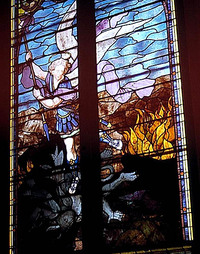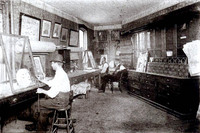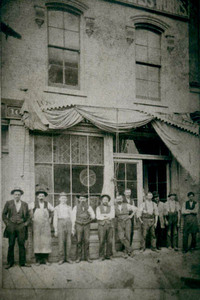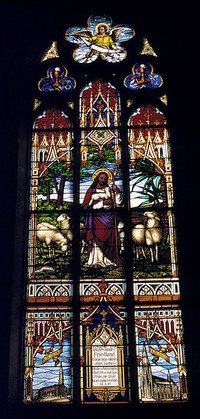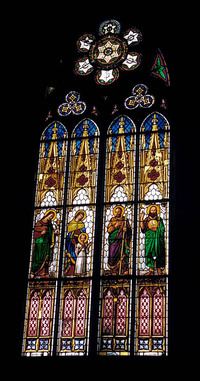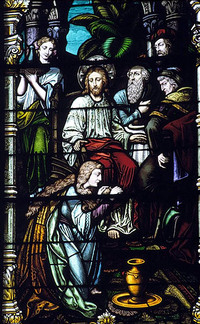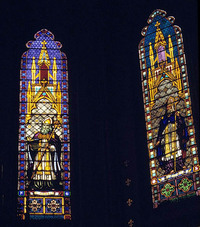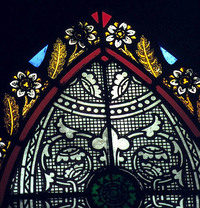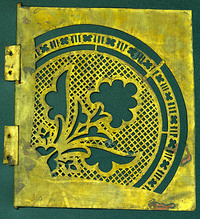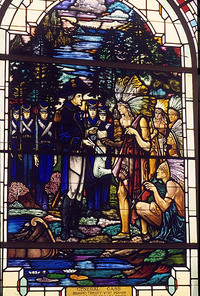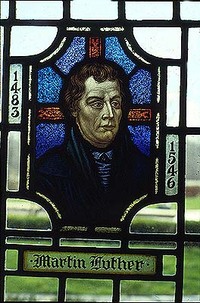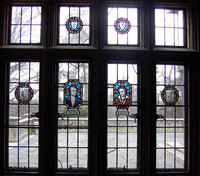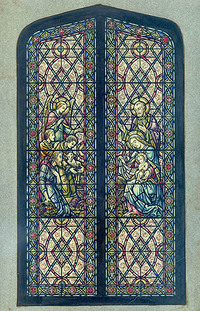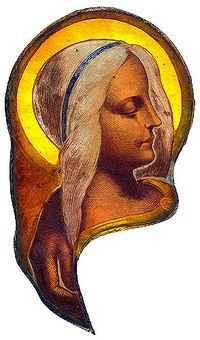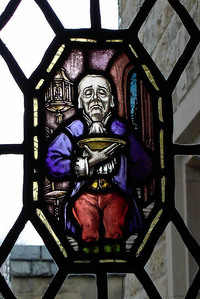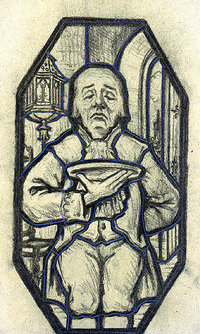MSGC : Featured Windows : Current Window
Featured Windows, February 2007
The Detroit Stained Glass Works
Buildings:
Saints Peter and Paul Church - Ionia, Michigan
Ste. Anne de Detroit Catholic Church - Detroit, Michigan
St. John's Seminary - Plymouth, Michigan
Sweetest Heart of Mary Church - Detroit, Michigan
Tuscola County Courthouse - Caro, Michigan
Thornville Baptist Church - Metamora, Michigan
Kirk in the Hills - Bloomfield Hills, Michigan
Scripps Mansion - Lake Orion, Michigan
St. Joseph Oratory, formerly St. Joseph Roman Catholic Church - Detroit, Michigan
Left: The Friederichs and Staffin stained glass studio with founders Charles P. Friederichs and Peter Staffin in the background and Charles P. Friederichs II seated at the left. Photo courtesy of Mary G. Payne.
Right: Owners and workers at the Friederichs and Staffin studio ca. 1880. Founders Peter Staffin and Charles Friederichs are second and fourth from the left. Ignace Schott, a painter with the firm, is third from the right. Photo courtesy of Mary G. Payne and Mary Ellen Bellaimey.
Renewed interest in Michigan's traditional crafts in the 21st century is the focus of "CraftWORKS! Michigan," a program developed by the state's Office of Cultural Economic Development in the Department of History, Arts and Libraries, in cooperation with Michigan State University Museum. As part of this new emphasis on the role of crafts in today's economy, our Windows of the Month during 2007 will present occasional articles on historic or contemporary stained glass studios and artists of Michigan. The history and work of the Detroit Stained Glass Works are featured this month.
The earliest known stained glass studio in Michigan, after statehood was granted in 1837, was the firm of Friederichs and Staffin, founded at Detroit in 1861 by Charles Friederichs (1838-1924), a native of Germany, and Peter Staffin (b. 1841) of New York State. An undated photo shows the men inside their studio with Friederichs' son Charles at work in the foreground (Fig. 1). "Detroit Stained Glass" was added to the firm's name in 1878. When Staffin left the studio in 1896, he was replaced by Edward Wolfram and the firm's name was changed to Friederichs and Wolfram. In 1909 it was changed again to the Detroit Window and Stained Glass Company. After Wolfram's departure in 1914, the name became the Detroit Stained Glass Works. For more than a century until it closed in 1970, this firm produced windows for churches, homes, steamboats and railroad cars in Michigan and several other states, in its two workshops at Detroit and Windsor, Ontario.
Although the names of many of its workers have been lost, some are known. In a photo of the owners and staff lined up in front of their shop, several individuals are identified. Staffin and Friederichs are second and fourth from the left. Among the identified workers is Ignace Schott, third from the right, partially hidden and wearing a jacket and derby hat. Schott (1818-1883) had come to the United States from France via Canada around 1869. According to his son, American painter Leon Scott Dabo (1865-1960), Schott had fled France to avoid political persecution, perhaps even death, and had changed his name from Ignace Scott Dabo to Ignace Schott. While working for Friederichs and Staffin during the 1870s, he painted several windows for churches in Detroit, Ohio, Tennessee and Windsor, including a signed window at Detroit's Most Holy Trinity Church. Other workers in the photo have been identified as Peter Karrer, Joseph Friederichs, Louis Wolfe, August Camine and Adam Staffin. During the 20th century, workers at the Detroit Stained Glass Works included Aloysius Weiss, Lemuel Irving, Mary Ellen Irving Bellaimey, Mary Giovann, Raymond Marion, Leo Weeg, Margaret Bouchez Cavanaugh and Vera Sattler.
Under its various names, the Detroit Stained Glass Works created windows in a wide range of styles for numerous Michigan buildings, many of which have been registered in the Michigan Stained Glass Census. The transept windows for Sweetest Heart of Mary Catholic Church, made in 1893, are said to have won a main prize at that year's World's Columbian Exposition in Chicago. Among eight nave windows made by Friederichs and Staffin for this Polish parish is a window depicting St. Michael the Archangel and the Dragon.
St. Michael the Archangel (detail). Sweetest Heart of Mary Catholic Church, Detroit, MI. Friederichs and Staffin, 1893. MSGC 92.0018. Photo by Barbara Krueger.
Left: Good Shepherd Friedland Memorial Window. St. Joseph Catholic Church, Detroit, MI. Friederichs and Staffin, 1899. MSGC 93.0064. Photo by William M. Worden.
Right: Holy Family with John the Baptist and John the Evangelist. St. Joseph Catholic Church, Detroit, MI. Friederichs and Staffin, 1873. MSGC 93.0064. Photo by William M. Worden.
A Good Shepherd window
(left), created by Friederichs and Staffin for St. Joseph Catholic Church, where Friederichs was a parishioner, is a memorial to the Rev. J. F. Friedland, a longtime pastor of the church. Two lower panels of the window hold images of the earlier frame church of 1855 and the present Gothic Revival limestone building of 1873, constructed during Fr. Friedland's pastorate. Several other windows in the church are also by Friederichs and Staffin, including a window depicting the Holy Family with John the Baptist and John the Evangelist
(right). The latter may have been the work of Ignace Schott, who painted the window at Most Holy Trinity Church during the same year.
Mary Washing Jesus' Feet (detail). Saints Peter and Paul Catholic Church, Ionia, MI. Friederichs and Staffin, 1882. MSGC 92.0016. Photo by Barbara Krueger.
In 1882, Friederichs and Staffin created nave windows for the new home of Saints Peter and Paul Catholic Church in Ionia, MI. Designed by noted Detroit architect Peter Dederichs, the cornerstone was laid in 1881 by Fr. Friedland of St. Joseph Church in Detroit. Among the nave windows are two depicting Jesus with the Children
(Window of the Month, July 2002) and Mary Washing Jesus' Feet. When transept wings were added in 1924, the same firm, now called the Detroit Stained Glass Works, provided two large transept windows depicting the Nativity
(Window of the Month, December 1999) and the Resurrection.
Right: St. Martin
(left) and St. Denis
(right). St. Anne Catholic Church, Detroit, MI. Friederichs and Staffin, 1886. MSGC 94.0058. Right: St. Denis close-up.
For the eighth home of St. Anne Catholic Church, built in 1886, Friederichs and Staffin created a series of five lancet windows for the chancel area, depicting St. Anne with the Virgin Mary and four patron saints of France: St. Eloi, St. Remi, St. Martin and St. Denis. St. Anne Church traces its history to the parish founded by the French explorer Cadillac after he landed in Detroit in 1701. Its chapel holds the tomb of Father Gabriel Richard, pastor of the church from 1798 until his death in 1832. Father Richard was a co-founder of the University of Michigan and a member of Congress, among many other achievements.
Left: Ornamental stenciled window (detail). Thornville Baptist Church, Metamora, MI. Friederichs and Staffin, 1885. MSGC 92.0038. Photo by Margaret Dudley.
Right: Brass stencil from Detroit Stained Glass Works. Michigan State University Museum Collection. Acc. No. 7567.3. Donated by Betty MacDowell.
Like other studios of its time, Friederichs and Staffin produced less costly "grisaille" stenciled windows for smaller churches. The Michigan Stained Glass Collection of stained glass artifacts at the Michigan State University Museum contains paper and brass stencils used by the studio to make this type of window. Examples of stenciled windows can be found in many Michigan churches.
Left: The Butler. Scripps Mansion, Lake Orion, MI. Attributed to the Detroit Stained Glass Works, 1927. MSGC 04.0001. Photo by Leslie Pielack.
Right: The Butler. Charcoal cartoon from the Detroit Stained Glass Works. Michigan State University Museum Collection, Acc. No. 7567.54. Donated by Marcia Carbone.
As the Detroit Stained Glass Works, the studio provided windows for Michigan churches and other buildings throughout much of the 20th century. Evidence suggests that the charming medallions made in 1927 for the windows of the William E. Scripps Mansion (now Guest House, Inc.) in Lake Orion, MI, were most likely created by the Detroit Stained Glass Works, rather than by an unknown English studio as was previously thought
(Window of the Month, July 2004). The Michigan Stained Glass Collection contains several charcoal cartoons from the now closed studio that are identical to some of the Scripps Mansion windows.
The Treaty of Saginaw. Tuscola County Courthouse, Caro, MI. Detroit Stained Glass Works, 1932. MSGC 94.0088. Photo by Barbara Krueger.
A window made in 1932 by the Detroit Stained Glass Works for the Tuscola County Courthouse at Caro, MI
(Window of the Month, November 1997), records a significant event in Michigan's history when General Lewis Cass and the Chippewa people signed the 1819 Treaty of Saginaw, transferring tribal lands to the United States government in exchange for payments, annuities and services.
Left: Martin Luther. Kirk in the Hills, Bloomfield Hills, MI. Detroit Stained Glass Works, 1949-1953. MSGC 98.0029. Photo courtesy of Kirk in the Hills.
Right: Robert Burns and Percy Bysshe Shelley. Scripps Mansion, Lake Orion, MI. Attributed to the Detroit Stained Glass Works, 1927. MSGC 04.0001. Photo by Leslie Pielack.
Between 1949 and 1953, the Detroit Stained Glass Works created twenty-one stained glass portrait medallions depicting Christian leaders for the cloister windows of Kirk in the Hills in Bloomfield Hills, MI (right)
(Window of the Month, August 2002). The design and colors of these medallions are strikingly similar to portrait medallions of Robert Burns and Percy Bysshe Shelley located in windows of the Scripps Mansion library
(left), a further indication that the Detroit Stained Glass Works probably created the earlier Scripps portraits as well.
The Exorcist
(left) and the Lector
(right). St. John's Provincial Seminary, Plymouth, MI. Margaret Bouchez Cavanaugh, designer, Detroit Stained Glass Works, 1954. MSGC 94.0067. Photo by Barbara Krueger.
During the 1950s and until its closing in 1970, the Detroit Stained Glass Works produced windows in more contemporary styles, designed by artists such as Mary Giovann, Mary Ellen Irving, Margaret Bouchez Cavanaugh (Windows of the Month,
May 1999. and
February 2006), and Vera Sattler
(Window of the Month, May 2006). Giovann, Irving and Cavanaugh were responsible for designing the windows in 1954 for St. John's Provincial Seminary in Plymouth, MI.
Left: The Nativity. Color maquette from Detroit Stained Glass Works. Michigan State University Museum Collection, Acc. No. 7567.5. Donated by Marcia Carbone.
Right: The Sacred Heart of Christ. Color maquette from Friederichs & Staffin. Michigan State University Museum Collection, Acc. No. 2001:215.17. Donated by Betty MacDowell.
Head of a Woman. Painted glass sample from Detroit Stained Glass Works. Michigan State University Museum Collection, Acc. No. 2003:1.2. Donated by Tom Newton.
The Michigan Stained Glass Collection of stained glass artifacts is a growing repository of materials related to Michigan's stained glass industry. In addition to charcoal cartoons and stencils, the collection contains glass cutters, color maquettes, sketches, glass samples, posters, studio ledgers, historic photos and windows, donated by Michigan artists, their families and other individuals. Many of these artifacts came from the Detroit Stained Glass Works.
Although the Detroit Stained Glass Works closed its doors in 1970 after operating for more than a century, its tradition of fine craftsmanship continues through the work of stained glass artists and studios active in Michigan today.
Bibliography:
Show BibliographyBellaimey, Therese and Mary Ellen Irving Bellaimey. The Windows of St. John's Seminary, Plymouth, Michigan. Detroit, MI: DSG Press, 1988.
Eckert, Kathryn Bishop. Buildings of Michigan. New York: Oxford University Press, 1993.
Ferry, W. Hawkins. The Buildings of Detroit. Detroit: Wayne State University Press, 1968.
Gibson, Arthur Hopkin. Artists of Early Michigan: A Biographical Dictionary of Artists Native to or Active in Michigan 1701-1900. Detroit: Wayne State University Press, 1975: 82-84; 210.
Kirk in the Hills. Welcome to the Kirk. Bloomfield Hills, MI: Kirk in the Hills, 1972.
Lewkow, Victoria. "Signature on Glass: Discovering the Art and Life of Ignace Schott." Michigan History Magazine (March/April 1995): 48-52.
MacDowell, Betty. "Michigan's Stained Glass Industry: Tradition and Innovation," in Yvonne R. Lockwood and Ruth Fitzgerald, eds. 1995 Festival of Michigan Folklife. East Lansing, MI: Michigan State University Museum, 1995.
Pancza, Arleen. "Leon Scott Dabo (1865-1960)." Artists of Michigan from the Nineteenth Century. Exhibition catalogue. Muskegon, MI: Muskegon Museum of Art, 1987: 154-159.
Skendzel, Eduard Adam. A Centennial Parish: A Brief Historical Overview, An Architectural Commentary, The Story of the Restoration of Sweetest Heart of Mary Church. Grand Rapids, MI: Littleshield Press, 1985.
St. Anne Church. "Ste. Anne de Detroit: Established 1701." (Booklet.) Detroit: St. Anne Church, n.d.
St. Joseph Roman Catholic Church. "Full History of St. Joseph's Church" (2007). http://www.saint-joseph-detroit.org/FullHistory.html
St. Joseph Roman Catholic Church. "St. Joseph Church: A Landmark of Faith and History." (Booklet.) Detroit: St. Joseph Church, 1976.
Sts. Peter and Paul Church. S. S. Peter and Paul Centennial Edition, Ionia, Michigan. Ionia, MI: Sts. Peter and Paul Church, 1982.
Tutag, Nola Huse. "Art in Glass: Detroit Stained Glass Works." Michigan History Magazine (September/October 1987): 21-22.
Tutag, Nola Huse with Lucy Hamilton. Discovering Stained Glass in Detroit. Detroit: Wayne State University Press, 1987. (MSGC 1993.0120, 1993.0064, 1992.0016, 1994.0058, 1992.0038, 1994.0088, 1998.0029, 2004.0001, 1994.0067, )
Text by Betty MacDowell, Michigan Stained Glass Census, February , 2007.

